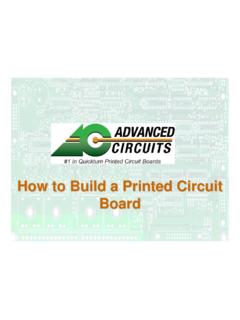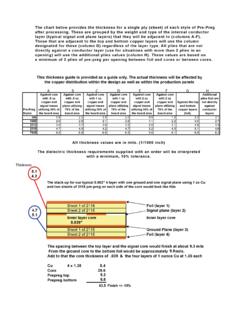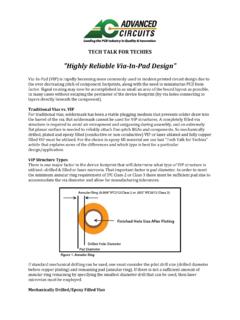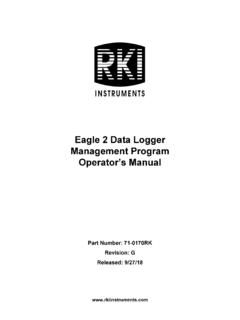Transcription of PCB Artist Tutorial - Advanced Circuits
1 PCB Artist Introduction and Tutorial 2 PCB Artist Tutorial Copyright Notice Copyright WestDev Ltd. 1997-2008 PCB Artist is a Trademark of Advanced Circuits . All rights reserved. E&OE Copyright in the whole and every part of this software and manual belongs to WestDev Ltd. and may not be used, sold, transferred, copied or reproduced in whole or in part in any manner or in any media to any person, without the prior written consent of WestDev Ltd. If you use this manual you do so at your own risk and on the understanding that neither WestDev Ltd. nor associated companies shall be liable for any loss or damage of any kind. WestDev Ltd. does not warrant that the software package will function properly in every hardware software environment. Although WestDev Ltd. has tested the software and reviewed the documentation, WestDev Ltd. makes no warranty or representation, either express or implied, with respect to this software or documentation, their quality, performance, merchantability, or fitness for a particular purpose.
2 This software and documentation are licensed 'as is', and you the licensee, by making use thereof, are assuming the entire risk as to their quality and performance. In no event will WestDev Ltd. be liable for direct, indirect, special, incidental, or consequential damage arising out of the use or inability to use the software or documentation, even if advised of the possibility of such damages. WestDev Ltd. reserves the right to alter, modify, correct and upgrade our software programs and publications without notice and without incurring liability. Microsoft, Windows, Windows NT and Intellimouse are either registered trademarks or trademarks of Microsoft Corporation. All other trademarks are acknowledged to their respective owners. Number One Systems & PCB Artist are trademarks of Westdev Ltd and Advanced Circuits respectively. Issue date: 18/09/08 iss 3 Advanced Circuits Inc.
3 21101 East 32nd Parkway Aurora, CO 80011 Toll free: 800-979-4 PCB (4722) 1-303-576-6610 Fax: 1-888-224-3291 PCB Artist Tutorial 3 Contents CHAPTER 1. GETTING Introduction to PCB Introduction to the Additional System Removing the Starting PCB The PCB Artist Cancelling Shortcut Shortcut 10 Properties of Status Dockable Windows and CHAPTER 2. CREATING THE Schematic Design Starting a New Adding Placing Adding Adding Power & Ground Adding Naming Your Schematic is CHAPTER 3. CONVERTING YOUR SCHEMATIC TO Converting the Schematic to Starting a New PCB The New PCB Schematic Design CHAPTER 4. PCB DESIGN Getting Started with the Converting the Schematic to Changing the Number of Creating a Board Outline Placing Routing the Automatic Unrouting the Manual 43 Picking in tight Pouring Copper into Checking the Design Design Rules 4 PCB Artist Tutorial Viewing Power Plane Reports, Part Lists and Net Manufacturing the Chapter 1 Getting Started 5 Chapter 1.
4 Getting Started Introduction to PCB Artist Welcome to the PCB Artist electronic design system. The system is built on an integrated design environment providing all the tools required to capture a schematic through to the design and layout of the printed circuit board (PCB). Introduction to the Tutorial You can quickly familiarize yourself with the PCB Artist features available and its design methodology by working your way through this Tutorial and using the Online Help for more detail. This Tutorial is broken down into logical sections following a typical Schematic and PCB design cycle. The Schematic design editor is used to capture your logical design and drive the PCB design. However, the PCB design editor can be used with or without the schematic design as you wish. An important aspect of the PCB design is the production of professional manufacturing data, and hence the final PCB.
5 PCB Artist has the facility to send the manufacturing data directly to your PCB supplier. From this data they can produce the final physical PCBs. Additional Help Help is available in a number of formats; on-line help available by pressing the F1 key on your keyboard at any time when using PCB Artist or by emailing/calling Advanced Circuits . System Requirements PCB Artist runs under the Windows operating systems but it is recommended that Windows XP is used. It cannot run under Windows or Linux. A Pentium processor faster than 1 Ghz and with at least 256Mb of RAM is recommended. It should be emphasized that PCB Artist does not require particularly high-powered hardware to achieve good performance, a regular off -the-shelf PC should be sufficient. A complete product installation requires at least 100Mb of hard drive space. A mouse with a wheel is recommended and an internet connection for downloading the product from the PCB Artist web site.
6 A CD-ROM drive is an option to load the product CD if it has been supplied this way. Installation It is assumed that you have successfully installed the PCB Artist product to your computer from the web download. The installation is straight forward using the wizard provided. Follow the instructions and use the default settings provided. The Tutorial designs are also installed to allow you to pick up at key stages of the design process. 6 Chapter 1 Getting Started Removing the Software If for any reason you need to remove PCB Artist from your computer, you should do this by selecting the Add/Remove Programs icon from the Control Panel on the Start menu. Select PCB Artist from the list of installed programs and click the Change/Remove button . Starting PCB Artist During installation, a PCB Artist program icon is automatically added to your desktop and a Advanced Circuits program group added to the Start menu and Programs.
7 To start PCB Artist , simply double-click on the PCB Artist icon on your desktop or select the PCB Artist menu item. The PCB Artist Desktop When you run PCB Artist , the main application window appears. You can open any number and combination of different designs and library items together in this. The picture below shows you the major framework facets by name so that as they are used in this Tutorial you will understand what is being talked about. Chapter 1 Getting Started 7 Toolbars PCB Artist is installed with a set of commonly used tools on the toolbars for you to use. General Toolbar Schematic Design Toolbar If you hover the mouse over the toolbar buttons a small tooltip is displayed showing the button function and its keyboard shortcut if one has been defined. PCB Design Toolbar 8 Chapter 1 Getting Started Cancelling Commands All dialogs and commands can be cancelled at any time by clicking the ESC key on the keyboard.
8 Sometimes this will need to be clicked a couple of times if you are down in a sub-menu or lower-level option. Shortcut Keys As well as the toolbars, PCB Artist has the ability for you to program your keyboard for commonly used options or commands. This means that once programmed, you can press a key or key combination to enter a function or option. For experienced users, this makes the program's operation far more efficient. When PCB Artist is installed, you will find a set of shortcuts defined for you. A full report of all the assigned keys can be obtained from the Help menu and Shortcut option. A dialog is displayed to allow you to choose how the shortcut keys are reported. Units The Units option on the Settings menu is used to define the units and the precision at which the co-ordinates and lengths displayed in the dialogs and edited by you are displayed.
9 The basic working units can be changed using the Units: drop down list. For each type of units, you can specify a Precision:. This is the number of decimal places displayed; the value is simply rounded to the nearest last digit. Chapter 1 Getting Started 9 Grids Grids are used in PCB Artist for defining the points or steps that items will snap to when they are placed and for visible references in the design. For this, the Grids dialog on the Settings menu contains two sets of grid types: Working Grid and Screen Grid. The Working Grid page will allow you to define the grid used for placement of design items during manual interaction. The working grid is not visible but the Screen Grid (which is visible) can be the same value, hence making it appear to be visible. The Screen Grid page is used to define the display of 'dots' to guide you while designing.
10 Size Steps: is used to define the pitch of the grid and uses the Secondary Color to display them. The Primary Color is used to display another grid based on a 10 times larger size than the Secondary Grid. The Visible check box enables the grids to be displayed on or off, this can be set at any time in the design using the shortcut key <G>. Snapping to Grid The Snap Mode shortcut can be displayed during editing by selecting the direct keyboard command <Ctrl-G>. By selecting the snap mode setting you can use predefined multiples of the Working Grid to move items for example. 10 Chapter 1 Getting Started Shortcut Menus The right hand mouse button can be used extensively throughout PCB Artist to display shortcut menus, these are also known as context menus. These menus can be accessed during an operation and contain a set of relevant 'context' commands. Once familiar with the system, you can access the shortcut menus by right clicking directly on the item and picking the option from the menu.






